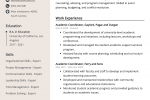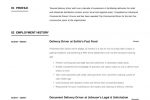Creating a Compelling Resume Narrative

Crafting a compelling resume goes beyond listing job experiences; it involves weaving a narrative that resonates with employers and leaves a lasting impression. Your resume is your personal marketing tool, and its ability to tell a compelling story about your professional journey is key to capturing the attention of potential employers.
Craft a captivating professional summary that provides a concise yet compelling overview of your career objectives, core strengths, and the value you bring to prospective employers. Make it an invitation for employers to delve deeper into your story.
Showcase achievements as milestones on your professional journey, demonstrating growth and progression. Position each accomplishment as a testament to how you overcame challenges and contributed to the success of your teams and projects.
Align your resume narrative with the values and culture of the companies you’re applying to. Highlight experiences and achievements that reflect your alignment with the company’s mission and goals. This not only resonates with employers but also positions you as a candidate who shares their values.
Incorporate action verbs to infuse energy and dynamism into your resume narrative. Use verbs that convey proactivity and impact, making your narrative more engaging and emphasizing your role as an active contributor in your professional journey.
Tailor your resume narrative for each application by emphasizing aspects of your story that are most relevant to the specific job. Showcase experiences and skills that directly align with the requirements outlined in the job description.
Maintain a consistent theme throughout your resume narrative. From the professional summary to the details of each role, ensure a cohesive story that reflects your overarching professional identity. Consistency contributes to a clear and memorable narrative.
Your resume should be a teaser that invites employers to want to learn more. Create a narrative that sparks curiosity and prompts questions. This encourages employers to delve deeper into your story during interviews and further stages of the hiring process.
Meticulously proofread your resume narrative. Typos and grammatical errors can disrupt the flow of your story and detract from your professionalism. Ensure that your resume is polished, error-free, and ready to leave a positive and lasting impression.
A compelling resume narrative is a powerful tool in the competitive job market. By treating your resume as a story that resonates with employers, you position yourself as a candidate who not only has the right skills but also a compelling professional journey worth exploring. Craft your narrative with intention, and let your resume be a story that captivates and leaves a memorable imprint on potential employers.





